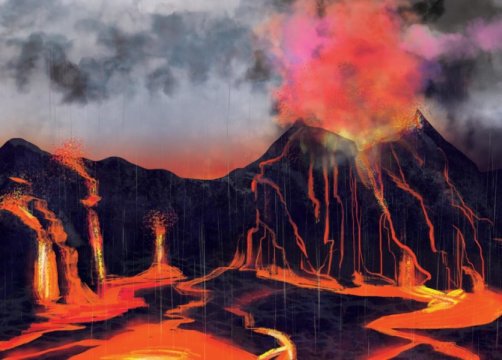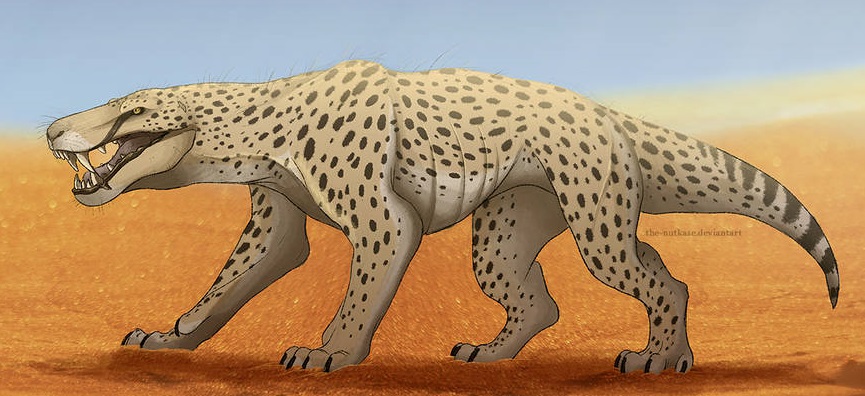New evidences of volcanic activity have been obtained that caused the most massive extinction in history.

Volcanic eruption in the pouring rain
Source: Illustration / Margaret Weiner / UC Creative Services
The researchers claim that the mercury hidden in the ancient rocks is a convincing proof that volcanoes were the cause of the most massive extinction of living beings in history.
The extinction of living beings that took place 252 million years ago was so vast and dramatic that scientists called it the Great. The disaster has destroyed more than 95 percent of life on earth for hundreds of thousands of years ( estimates of the duration of the extinction period in different publications differ - approx. Transl. ).
Paleontologists together with the University of Cincinnati ( Eng. - University of Cincinnati , USA) and China University of Geosciences (Eng. - China University of Geosciences) state that they recorded a sharp increase in the amount of mercury in the geological profile of a dozen places around the globe. In their opinion, this is convincing evidence that volcanic eruptions have led to a global catastrophe.
')
The study was published this month in the journal Nature Communications.
Volcanic eruptions have ignited vast deposits of coal, releasing mercury vapor into the atmosphere. In the end, it fell rain and settled in sediments all over the planet, becoming evidence of a catastrophe that marked the beginning of the dinosaur era.
“Volcanic activity, which includes the release of volcanic gases and the burning of organic material, released an excess of mercury, which was then deposited on the surface of the Earth,” said lead author, Jun Shen, associate professor at China University of Geosciences.
Mass extinction took place on the border between the Permian and Triassic geological periods. It led to the destruction of most of the representatives of the land and marine flora and fauna before the era of dinosaurs. Some of the extinct species were prehistoric monsters, such as the formidable gorgonopses, which looked like a cross between a saber-toothed tiger and a monitor lizard.

Reconstruction of the appearance of the gorgonopside. Posted by: NutkaseCreates
Eruptions originated in a volcanic system called the “Siberian Traps”, located in the Siberian part of modern Russia. Many of the eruptions did not come from conical volcanoes, but from faults on the surface of the earth. Eruptions were frequent and long; their total duration dragged on for a period of hundreds of thousands of years.
"Usually, during a turbulent volcanic eruption, a large amount of mercury enters the atmosphere," said Thomas Algeo, a professor of geology at the College of Humanities and Natural Sciences at the University of Cincinnati.
“Mercury is a relatively new indicator for researchers. It has become relevant when studying the degree of impact of volcanoes on major events in the history of the planet, ”he added.
To determine the age of the rock in which mercury was found, the researchers used the fossilized teeth of a conodont , a creature resembling a modern lamprey. Like many other species, the conodonts were destroyed by the disaster.
During the entire period of eruptions, about three million cubic kilometers of ash were thrown into the air. For comparison, during the eruption of the volcano St. Helens in Washington State, 1 cubic kilometer was thrown into the air. Then the ash fell on the windshields of cars in Oklahoma ( this is at a distance of more than 2 thousand km. - approx transl. )
“Essentially,” says Thomas Algeo, “Siberian traps have thrown such a large amount of material, especially greenhouse gases, into the air that this has increased the temperature of the planet by an average of 10 degrees Celsius.”
“Warming is likely to be one of the main culprits of mass extinction,” he says. “Poisonous rains poisoned a large number of water sources and increased ocean acidity. Because of the lack of dissolved oxygen, lifeless zones appeared in the warm water. ”
“We often think about what was fatal from the above. Creatures accustomed to colder conditions had no chance, ”says Thomas Algeo.“ In my opinion, the temperature leap is the culprit number 1. The conditions were aggravated by the release of toxic substances into the environment. ”
Stretching for a long period of time, eruptions after eruptions did not allow the food chain on our planet to recover.
"It is not the intensity that is important, but the duration of the process described," says Thomas Algeo. "The longer it lasted, the greater the impact it had on the environment."
"Thus, the planet was very slowly recovering from the consequences of the disaster, due to the fact that the shocks continued to destroy its biological diversity."
For 4.5 billion years, the Earth has witnessed five mass extinctions.
Scientists use another elemental indicator, iridium, to determine the cause of global extinction, which wiped out dinosaurs about 65 million years ago. They believe that a huge meteorite collapsed on the territory of modern Mexico.
As a result, incandescent masses of the earth were emitted into the atmosphere and settled as a substance containing iridium, which was found in the geological profile throughout the globe.
Jun Shen states that the mercury trace constitutes convincing evidence that the eruptions of the Siberian traps are responsible for the catastrophe. At the moment, researchers are trying to determine the extent of eruptions and which of their consequences is the main cause of mass death, in particular, of animals and plants on earth.
Shen believes that Permian extinction may shed light on today's global warming, which could lead to the next global extinction. If global warming is actually responsible for the extinction of species in the Permian period, then what is the current warming for life on Earth?
“The release of man-made combustion products into the atmosphere resembles the situation at the end of the Permian period when an excess of carbon was released into the atmosphere,” says Jun Shen.
Thomas Algeo also calls this cause of concern.
“Most biologists believe that we are on the verge of another big global extinction - the 6th. I share this view, ”says Algeo. "We must understand that this is a serious process that will harm all of humanity, and work to minimize the damage."
People living in extreme conditions, such as waterless deserts, will be the first to suffer, leading to a large number of climate refugees around the globe.
“Most likely, we will see even more hunger and mass migration in places where the blow will be the hardest. This is a global issue and we should take proactive steps. The problem is easier to fight until it has turned into a crisis. ”
Link to study materials:
Jun Shen, Jiubin Chen, Thomas J. Algeo, Shengliu Yuan, Qinglai Feng, Jianxin Yu, Lian Zhou, Brennan O'Connell, Noah J. Planavsky. Evidence for a prolonged Permian – Triassic extinction interval from global marine mercury records. Nature Communications, 2019; 10 (1) DOI: 10.1038 / s41467-019-09620-0
Source: https://habr.com/ru/post/448374/
All Articles